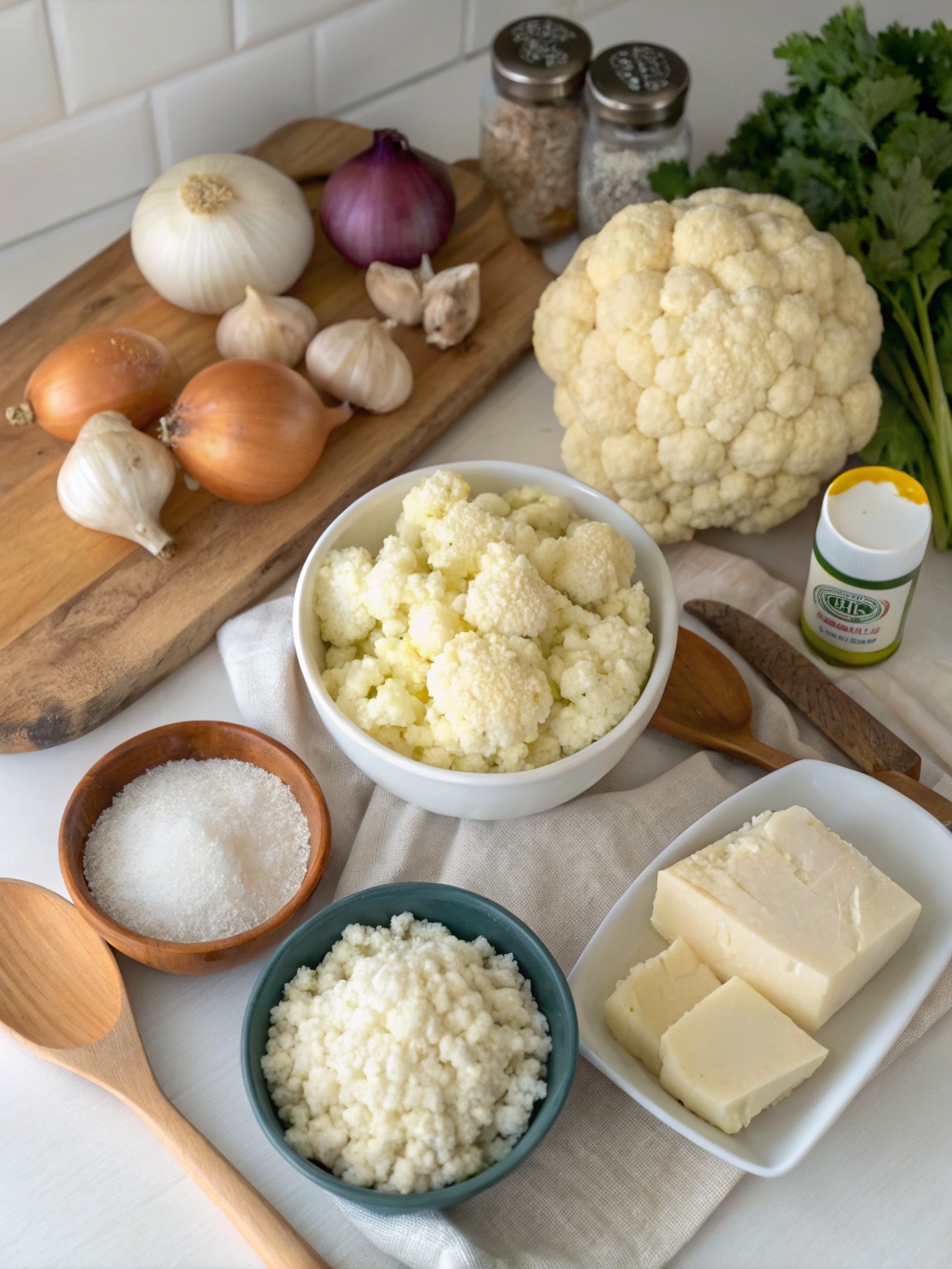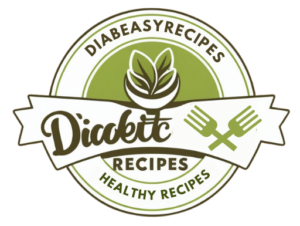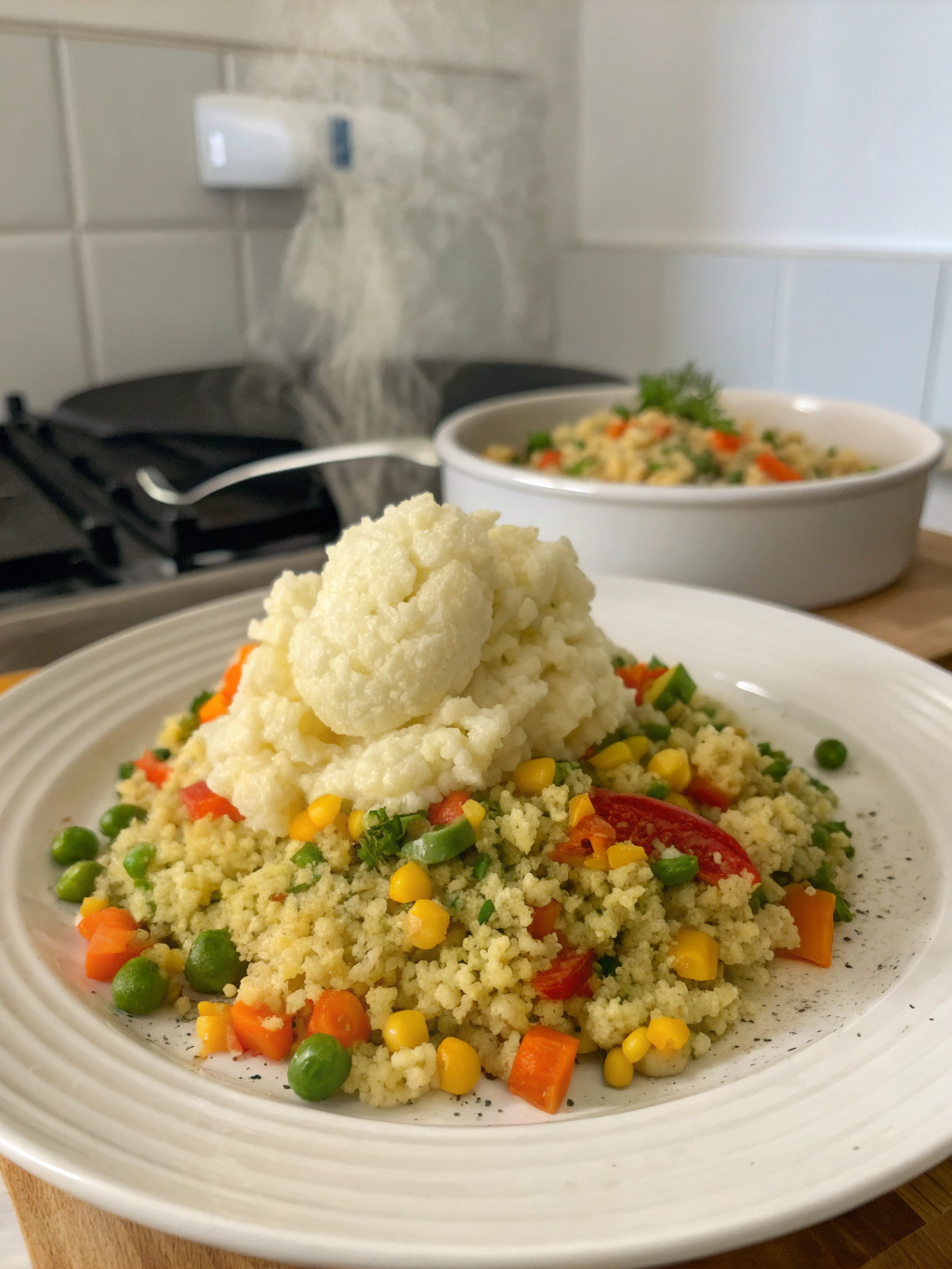Table of Contents
Introduction
Did you know that replacing regular rice and potatoes with cauliflower alternatives can reduce your carbohydrate intake by up to 75%? For the 37 million Americans living with diabetes, this simple swap could make a significant difference in blood sugar management. Cauliflower Veggie Rice and Mash offers the creamy texture and satisfying comfort of traditional sides without the carbohydrate spike. This versatile vegetable has transformed how we approach comfort food, providing a nutrient-dense alternative that’s as delicious as it is beneficial for blood sugar control. Whether you’re managing diabetes or simply seeking healthier options, these cauliflower transformations deliver flavor without compromise.
Ingredients List

For Cauliflower Rice:
- 1 medium head cauliflower (about 2 pounds)
- 2 tablespoons olive oil or avocado oil
- 1/2 medium onion, finely diced
- 2 cloves garlic, minced
- 1/4 cup low-sodium vegetable broth (substitute: chicken broth for non-vegetarians)
- 1 tablespoon fresh herbs (parsley, chives, or cilantro)
- Salt and pepper to taste
- Optional: 1/4 teaspoon turmeric for color and anti-inflammatory benefits
Tools you’ll need 👉 Click to buy on Amazon

For Cauliflower Mash:
- 1 medium head cauliflower (about 2 pounds)
- 2 tablespoons unsalted butter or olive oil
- 2 tablespoons cream cheese or Greek yogurt for creaminess
- 1/4 cup grated Parmesan cheese
- 2 cloves roasted garlic
- 1/4 teaspoon nutmeg (adds warmth without sweetness)
- Salt and pepper to taste
- Optional: 1 tablespoon fresh chives or parsley for garnish
Timing
Preparation Time: 15 minutes (30% less prep time than traditional mashed potatoes)
Cooking Time: 25 minutes
Total Time: 40 minutes
The efficiency of this recipe saves you valuable time compared to traditional methods, while the cooking process ensures optimal texture and flavor development. The quick preparation makes this an accessible weeknight option for busy households managing dietary needs.
Step-by-Step Instructions
Step 1: Prepare the Cauliflower
Break down the cauliflower head by removing the leaves and core. Cut into florets of roughly equal size to ensure even cooking. Rinse thoroughly under cold water to remove any hidden debris.
Pro tip: Don’t discard the cauliflower stem! It’s perfectly edible and works well in both rice and mash preparations.
Step 2: Create Cauliflower Rice
For the rice texture, pulse the cauliflower florets in a food processor until they reach a rice-like consistency. Work in batches to avoid overcrowding, which leads to uneven textures. Aim for pieces about the size of rice grains.
Alternative method: If you don’t have a food processor, use a box grater with the medium-sized holes to create the rice texture by hand.
Step 3: Cook the Cauliflower Rice
Heat olive oil in a large skillet over medium heat. Add the diced onion and sauté until translucent (about 3 minutes). Add minced garlic and cook for 30 seconds until fragrant. Add the cauliflower rice and sauté for 5-7 minutes, stirring occasionally.
Pour in the vegetable broth, cover, and let steam for 3-5 minutes until tender but not mushy. The perfect cauliflower rice diabetic, veggie mash diabetic, low carb side diabetic, mashed cauliflower diet, diabetic veggie swap maintains a slight bite.
Step 4: Prepare Cauliflower for Mash
For the mash, steam the cauliflower florets until fork-tender, about 10-12 minutes. Alternatively, boil them in lightly salted water for 8-10 minutes.
Critical tip: Thoroughly drain the cauliflower after cooking. Excess water creates a runny mash texture that won’t hold up well on your plate.
Step 5: Create the Perfect Mash
Transfer the cooked cauliflower to a food processor. Add butter or olive oil, cream cheese, Parmesan, roasted garlic, and seasonings. Pulse until smooth and creamy, scraping down the sides as needed.
For a chunkier texture, use a potato masher instead of a food processor, giving you control over the final consistency.
Tools you’ll need 👉 Click to buy on Amazon

Nutritional Information
Per 1 cup serving of Cauliflower Rice:
- Calories: 75
- Carbohydrates: 8g (compared to 45g in white rice)
- Fiber: 3g
- Protein: 2g
- Fat: 4g
- Glycemic Index: Low (unlike traditional rice with a high GI of 70+)
Per 1 cup serving of Cauliflower Mash:
- Calories: 115
- Carbohydrates: 8g (compared to 30g in mashed potatoes)
- Fiber: 3g
- Protein: 5g
- Fat: 8g
- Glycemic Index: Low (compared to mashed potatoes with a moderate GI of 50-60)
Healthier Alternatives for the Recipe
For lower sodium needs, eliminate the added salt and boost flavor with herbs like rosemary, thyme, or dill. For dairy-free adaptations, substitute nutritional yeast for Parmesan cheese and use coconut oil or olive oil instead of butter.
Those seeking higher protein content can incorporate 1/4 cup of hemp seeds into the mash or blend in 2 tablespoons of unflavored protein powder. For additional nutrients, try “rainbow rice” by adding finely diced colorful vegetables like bell peppers, carrots, or zucchini to your cauliflower rice.
Serving Suggestions
Pair cauliflower rice with grilled proteins like salmon or chicken for a complete meal with balanced macronutrients. The mash works beautifully alongside braised short ribs or as a base for vegetable-forward grain bowls.
Create a comfort food experience by using the mash to top shepherd’s pie made with lean ground turkey instead of beef. For a breakfast option, form chilled cauliflower rice into patties, pan-fry, and top with a poached egg for a nutritious start to your day.
Common Mistakes to Avoid
Overprocessing the cauliflower for rice results in a mushy consistency. Pulse carefully in short bursts to maintain the desired texture. Not removing excess moisture is the primary reason for watery mash – use a clean kitchen towel to press out additional liquid after cooking.
Skipping the resting period after cooking can lead to less flavorful results. Allow your finished dishes to rest for 5 minutes before serving to let flavors meld properly. Many cooks also over-season initially – start with less salt and adjust to taste, as flavors concentrate during cooking.
Storing Tips for the Recipe
Both cauliflower rice and mash keep well in airtight containers in the refrigerator for 3-4 days. For meal prep, portion into individual containers for quick access during busy weekdays.
To freeze, cool completely then store in freezer-safe bags with air removed. Frozen cauliflower rice maintains quality for up to 3 months, while mash is best used within 2 months. Reheat rice in a skillet with a splash of water or broth, and revive mash with a little butter or cream in the microwave or stovetop.
Tools you’ll need 👉 Click to buy on Amazon

Conclusion
Embracing Cauliflower Veggie Rice and Mash opens a world of possibility for those managing diabetes or reducing carbohydrate intake. These versatile preparations deliver the comfort and satisfaction of traditional sides while supporting stable blood sugar levels. The nutritional benefits combined with flavor adaptability make this a worthwhile addition to your regular meal rotation. Try these recipes this week and discover how a simple vegetable swap can transform your approach to healthy eating without sacrificing the comfort food experience you crave.
FAQs
Can I make cauliflower rice without a food processor?
Yes, you can use a box grater or even a knife to finely chop cauliflower into rice-sized pieces. The texture may be less uniform but still works well in recipes.
Why is my cauliflower mash watery?
This typically happens when the cauliflower isn’t properly drained after cooking. Try roasting the cauliflower instead of boiling or thoroughly drain and pat dry with paper towels before processing.
How can I add more protein to these dishes?
Mix in nutritional yeast, Parmesan cheese, or unflavored protein powder. For the rice version, sauté with egg whites or mix with cooked quinoa for a complete protein source.
Can these recipes be made in advance for meal prep?
Absolutely! Both the rice and mash store well for 3-4 days refrigerated or can be frozen for longer storage. They reheat beautifully with a touch of fresh herbs to brighten the flavor.
Is cauliflower rice actually good for controlling blood sugar?
Yes. With approximately 70% fewer carbohydrates than white rice, cauliflower rice has a significantly lower impact on blood glucose levels, making it an excellent choice for diabetes management according to the American Diabetes Association.
Did you try our recipe ?
There are no reviews yet. Be the first one to write one.

